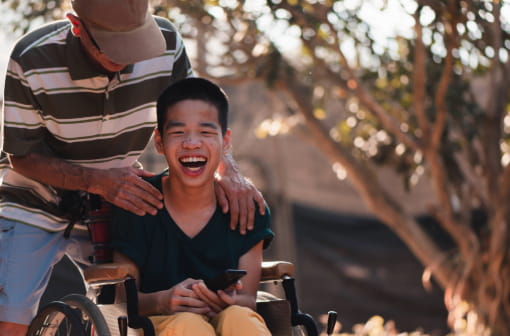“Pain is invisible, but that doesn’t mean it isn’t real.”—Nicolette Ellis, Chairperson of Chronic Pain Australia
Key points
- Peer groups, advocacy organisations and informed health professionals can provide validation, practical tips and emotional relief.
- Chronic pain is complex but manageable. Effective support often starts with self-education and an individualised care plan.
- Pacing your activity, managing stress and maintaining social connection can help you manage pain.
Chronic pain affects one in five Australians aged 45 and over—and it’s much more than just a physical issue. For the 3.6 million people living with it every day, chronic pain can disrupt their work, sleep, social life and wellbeing.
“Pain doesn’t discriminate,” says Nicolette Ellis, Chairperson of Chronic Pain Australia. “It affects people of all ages, backgrounds and walks of life. And it often goes unseen and misunderstood, even by health professionals.” In fact, one in five children also suffer.
So how can you take charge of your health if you or someone you love is living with chronic pain? We asked Nicolette to share practical strategies for managing pain and maintaining quality of life.

What causes chronic pain?
“Chronic pain is with me every day,” says 70-year-old Maria Axios, who lives with sarcoidosis, osteoarthritis and type 2 diabetes. “It never really goes away. But I’ve learned to keep going, even on the hard days.”
Chronic pain is defined as pain that lasts longer than three to six months. It can develop after an injury or illness, or appear without a clear cause.
“There are over 250 types of chronic pain conditions,” explains Nicolette. “Some are musculoskeletal, others neurological, autoimmune or trauma-related. Genetics, mental health, neurodivergence and past injury can all play a role.”
She adds that while certain groups are more likely to experience chronic pain—including First Nations peoples, refugee and culturally diverse communities, older adults, the LGBTQIA+ community, neurodivergent Australians and those with ADHD—it can affect anyone, at any point in life.
“We tend to think of chronic pain as an older person’s condition,” she says. “And, yes, it is more prevalent in older people, with one in three people over 65 experiencing chronic pain. However, one in five children, between seven and 18, lives with chronic pain as well. So, it doesn’t discriminate in age.”
Building your support team
With so many possible causes and contributions, treating pain is highly individualised and should take a biological, psychological and social approach that looks at the whole person. But no matter the source, Nicolette notes that people tend to do best when they’re actively involved in their own care.
That means:
- learning as much as you can about your condition
- asking questions and advocating for yourself
- building a support team that works for you.
For Maria, finding support has meant trying a variety of approaches, from medication to physiotherapy, hydrotherapy and heat treatments like saunas.
“The spa and sauna helped for a while,” she says. “It wasn’t a fix, but it gave me some relief and a bit of joy, and I try to hold onto that.”
Many people benefit from working with allied health professionals, such as myotherapists, chiropractors or osteopaths, as well as those that take a less interventionalist approach, such as exercise physiologists, psychologists and pharmacists. Each can offer personalised treatment strategies to support mobility, reduce tension and manage long-term pain.
Physiotherapists, in particular, are often well trained in pain assessment and management, says Nicolette.
“If you’re unsure where to start, a pain-informed physiotherapist can be a great first step,” explains Nicolette. “They can complete accredited training through the Australian Physiotherapy Association, and many are skilled at recognising and working with various pain conditions.”

Taking back control
Living with chronic pain can be incredibly isolating, especially when it impacts on your relationships, career and mental health.
“One in two people with chronic pain lose their job,” says Nicolette. “It changes your identity. It affects how you connect with others. And it can make you feel like you’re not being heard.”
That’s why peer support can be so powerful, including condition-specific communities online.
“There’s something life-changing about talking to someone who really gets it,” says Nicolette. “Other people living with the same condition can help you navigate the system, validate your experience and offer practical support.”
When asked about how pain has affected her social life, Maria admits that it’s made it difficult to get out and about.
“It’s disappointing,” she says. “I can’t walk much anymore. Even pushing a shopping trolley hurts. I’ve accepted it, but it still gets me down a lot.”
Still, she’s found ways to maintain her sense of self. “Having a routine, keeping the house clean, tending to the garden—those little things give me a sense of purpose,” she says.
That’s no coincidence, according to Nicolette.
“When you’re not engaging in the things you love, your pain signals actually amplify,” says Nicolette. “So part of managing pain is slowly reintroducing activities that nourish you, bit by bit, in ways that feel safe and manageable.”
Strategies that make a difference
Consistency is key when managing pain. That means:
- pacing activities to avoid overexertion and flare-ups
- incorporating gentle movement, such as physiotherapy or walking
- managing stress through techniques like mindfulness, counselling or support groups
- maintaining connection and purpose, even if it looks different now.
Learning how to balance activity with rest hasn’t been easy for Maria.
“I want to do things—I used to love gardening,” she says. “Now I have to sit down a lot. Start again. Sit again. It’s frustrating, but I’ve learned to work around it.”
Nicolette often uses the “spoon theory” to help people understand energy budgeting.
“Imagine starting your day with 10 spoons,” she explains. “Each task—showering, getting dressed, making breakfast—might cost a spoon. Once you’re out of spoons, you’re done for the day.
“When you think about it that way, it then becomes about being nice to yourself and planning how to use your spoons in ways that are nurturing and bring you joy.”

If you’ve recently been diagnosed with a chronic condition
Being diagnosed with any sort of chronic condition can be overwhelming, but you don’t have to go it alone.
“Reach out early,” advises Nicolette. “Find a trusted support network. Learn about your condition. And start building a care team you feel safe with—one that really listens to you.”
And try not to fall into the trap of pushing through.
“That ‘tough it out’ mentality doesn’t help,” she says. “Pacing, acceptance and self-compassion are what really matter. And remember—this is a condition you can live well with. There is hope.”
Understanding the impact on wellbeing
One of the least talked-about aspects of chronic pain is grief.
“People grieve the life they had before pain,” says Nicolette. “It might be a job, a sense of freedom, physical ability or even their identity. And that grief doesn’t just go away—it’s something you work through, again and again.”
That’s why open, honest conversations matter. And why we need to challenge the idea that if someone doesn’t look unwell, they must be fine.
“Pain is invisible, but that doesn’t mean it isn’t real,” adds Nicolette. “And when people feel dismissed—by society, by doctors, even by friends—it only adds to their suffering.”
Maria understands this frustration well. “People think the pain is all in your mind—but it’s not,” she says. “It’s every day. It stops you from doing the things you want to do. I just wish there was something that truly helped.”
What Nicolette wants people to know is that there is support. There are people who understand. And it is possible to live a meaningful, connected life while managing pain.
Chronic pain is widespread and complex, but manageable. With the right support, knowledge and care, people can take back control of their health and wellbeing.
“I do what I can,” says Maria. “It’s not always easy, but when I’ve cleaned the house or tended the garden, even for a little while, I feel like myself again.
For practical help or someone to talk to, contact Chronic Pain Australia’s PainLink helpline on 1300 340 357.
Reducing the stigma of chronic pain during National Pain Week: (21-27 July)
National Pain Week is a time to raise awareness about the daily reality of chronic pain, and to ensure the voices of people living with pain are heard.
More than 3.6 million Australians live with chronic pain, yet it often remains invisible, misunderstood or dismissed. National Pain Week is about changing that—through greater understanding, empathy and support.
To help someone living with chronic pain:
Believe them. Validate their experience, even if you can’t see it.
Be flexible. Understand that their energy and ability can change day to day.
Offer practical support. Like running errands or helping with appointments.
Keep inviting them to connect. Even if they can’t always say “yes”.
Ask them what they need. Because every person’s pain journey is different.
For more information, visit Chronic Pain Australia’s National Pain Week hub.


